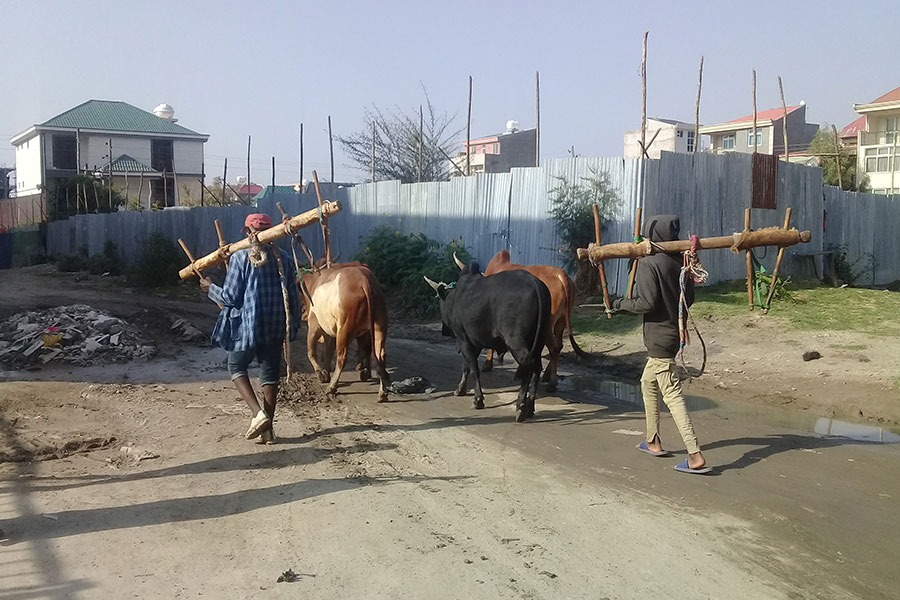
Radar | Jun 18,2022
It was the first time that 12-year-old Anisa Ali had ever seen desert locust swarms of this magnitude as they flew in over her neighbourhood. She had accompanied her father, Ali Jaaro, to their fields to protect crops from the insects.
Their community in Kemise Wereda had been fending off locusts since June 2019 but in small numbers. They have been sure to inform the local administration each time they encountered the insects, but the colossal swarms of locusts that flew in last month needed no introduction.
"We couldn't see the sun anymore," said Ali, who grows corn on his fields. "It was as if the sky had suddenly gone grey with clouds."
Ali and his neighbours did everything they could to fight off the locusts. They cracked whips woven from braided tree fibres to scare them away with noise. They burned tyres and anything else they could spare as the locust is known to detest smoke. When that failed, and the pests managed to land on their corn, they tried shaking the stalks.
But they were heavily outnumbered.
"Can you count the raindrops from the sky?" said Ali. "That's what we were up against."
At one point, his daughter had run away yelling, and the family paused their efforts momentarily to take her home before returning to the fields.
"She'd never seen them in this number," said Ali.
She was witnessing her father's farm getting destroyed. It was difficult for her. Within three days, Ali's farm, along with neighbouring farms, had been licked clean by the locusts.
The 12-year-old Anisa and her family certainly were not the only ones to see locust plagues of this magnitude. The problem of locust infestation is happening across five regional states and one administrative city in the country.
In fact, the problem goes far beyond the country and across borders into Eritrea, Somalia, Djibouti, Sudan and Kenya. An invasion of this magnitude has not been seen here in over 25 years, according to data from the Desert Locust Control Organisation for Eastern Africa (DLCO-EA). In neighbouring Kenya, the figure is 75 years.
The Organisation, with the mandate to operate in nine East African countries, has been working on pest management in the region since 1962. The four pests it covers primarily are the African armyworm, tsetse fly, desert locust and the quelea bird. The latter is a notorious avian pest that, not unlike the locust, moves in groups of massive size numbering up to 100,000 in a single flock. But unlike the desert locust, the selective quelea do not feed on corn or sunflowers.
The organisation is working closely with the Ministry of Agriculture and the Food & Agriculture Organisation (FAO) to respond to the call. With funds coming from member countries, it has deployed one aircraft to assist in control efforts.
"We're working in Dire Dawa and Jigjiga," said Stephen W. Njoka, director at the Organisation. "We'll be moving on once this situation is under control."
The Ministry of Agriculture has assessed over 850,000ha of land, a quarter of which has been infested by desert locusts.
In September, the Organisation treated over 57,000ha with pesticides using a combination of aerial and ground control teams. But the vegetation and wet soil due to continued rains created the perfect ground for further breeding.
"Pesticides through an aerial application is the most effective method," said Stephen. "We've requested more support to purchase effective aircraft."
The origin of the current crisis goes back to the Arabian Peninsula nearly two years ago, according to reports from FAO.
Cyclones bringing along heavy rains enabled these locusts to proliferate. Undetected and away from prying eyes, three generations of locust breeding took place. Their numbers grew 8,000-fold according to the FAO. The locusts then made their way to the Horn of Africa and Southeast Asia.
When they first started appearing in Ethiopia in June 2019, local farmers had some success in shooing them away. But as the months progressed, so did the intensity of the invasions.
Hussien Ibrahim, a farmer living in Kemise, administrative centre of the Oromia Zone in Amhara Regional State, has lost two hectares of millet and sesame after his efforts to shake off the pests proved futile.
"We were in the fields every day trying to shake them off our crops," said the father of four. "But finally, even the aeroplanes couldn't fight them off."
The crops began falling with the weight of the locusts on them, and the farmers were even afraid for their personal safety.
"They fly into your eyes when you try and shoot them away," he said. "We had to close our homes, so they wouldn't get into where we live."
Registration of community members in Kemise is taking place to assess the level of impact in the area. The main reason is to keep farmers in their homes to avoid displacement, according to Hussien.
Hussein was a mere month away from harvesting his crop when this happened. But he does not seem defeated despite having to start all over again.
"If we get irrigated water, we'll continue to sow seeds for the coming season," he said.
His region borders Afar Regional State, where 28 of the 34 weredashave been impacted.
The FAO, the main aid institution behind the containment efforts, has allocated two planes out of the four total operating aircraft solely for use in this region. Funding is secured for the aircraft until the end of this year along with around 40 vehicles and various spraying equipment. Its Desert Locust Upsurge Response Plan has killed an estimated 515 billion desert locusts across the 10 countries it operates in.
The FAO coordinates with the Plant Protection Directorate under the Ministry of Agriculture in exchanging information and real-time data. Though critical, this has been the most challenging aspect, according to the Organisation's progress report.
A digital application, eLocust3m, has also been launched; but with little access to cellphones in the region, it has yet to reach wide usage.
The reason that the condition in Afar Regional State is worse is due to the sparsity of settlements, according to Tamiru Kebede, director of plant protection under the Ministry.
"The community lives far apart from each other," he said. "It's difficult to coordinate information between them."
There are many methods the Directorate encourages community members to use in fending off the insects.
As the insects are cold-blooded, community members are encouraged to kill them off during early mornings or late nights while they stay immobilised. Another method is creating holes in the ground and leading the pests there as they start to hatch, according to the director.
"But it is tough," he said, "as the locusts have landed in very hard to reach areas."
Just last week, two aeroplanes secured by the Ministry crashed at different sites as they were flying low to reach difficult topographies. The aircraft were destroyed, but no lives were lost.
There are two aeroplanes in operation now, with another held up under repair, according to the Ministry. This is where the support is urgently needed. Pesticides, sourced mainly from Adami Tulu Pesticide Processing Factory, are available in adequate amounts until the end of the year.
Assessment from the Ministry of Agriculture shows that close to 281,000ha of land have been infested by locusts, with severe implications for crop harvests and livelihoods. A little over half of this land has been treated with pesticides since July.
A total of 2.4 million hectares of farming and pasture lands are expected to be impacted, which may cause food insecurity.
The food crisis comes as a compounded issue of the desert locust, floods, drought, and the impacts of the Novel Coronavirus (COVID-19). The government has put forth a total of 187 million dollars from the required 593 million dollars to address this need.
Emana Getu (Prof.), an expert in plant sciences and entomology, believes the reasons why desert locusts have proliferated this year is something that requires a closer look.
One reason could be that the country is facing a new type of locust breed as a result of interbreeding between previously known species. This is hard to monitor as locust behaviour is extremely erratic, according to him.
The unusual rainfall that has resulted in ample vegetation may be another reason.
"The insects come looking for food," he said. "Along with strong winds that may have carried them here, this could be the reason."
But the expert also suspects that most of these insects could have been bred within the country as well.
"There was an attempt to contain the locust through spraying insecticides a few months ago," he said. "But it might have taken place after the insects already layed their eggs."
The spraying of insecticides may be futile since the insects lay their eggs quite deep in the ground, according to the expert.
The widespread use of pesticides is also concerning.
The Ministry of Agriculture has reported the use of 200,000lt of insecticides since March. This will undoubtedly have adverse effects as it is poisonous and normally a last resort, according to Emana.
"We need to assess the amount, type and duration of insecticide use," he said. "It could end up killing animals that eat the infected vegetation. It might harm important flora in the environment and, in the worst cases, even people."
But the other alternative, the destruction that these pests could inflict, is a much greater problem that makes the insecticides a necessary evil, according to Emana.
The Ministry states that it is assessing how much assistance will be needed as the FAO targets 70,000 households for a livelihood recovery programme.
Farmers in Kemise, however, are already selling what little they have to buy food, according to Ali.
"This would be the time we bring in some corn for food to our homes," he said. But buying corn is also difficult as the price of corn has almost doubled to 700 Br for 50Kg because of the shortage.
"The farmers are washing belongings such as bedding to take and sell in town to buy food," he said.
They are doing this while one of the coldest months of the year approaches.
PUBLISHED ON
Oct 17,2020 [ VOL
21 , NO
1068]

Radar | Jun 18,2022

Viewpoints | Dec 14,2024

Fineline | Jan 26,2019

Radar | Nov 14,2020

Viewpoints | Feb 17,2024

In-Picture | May 24,2025

Fortune News | Jun 25,2022

Fortune News | Dec 28,2019

Radar | Nov 19,2022

Viewpoints | Nov 25,2023

Dec 22 , 2024 . By TIZITA SHEWAFERAW
Charged with transforming colossal state-owned enterprises into modern and competitiv...

Aug 18 , 2024 . By AKSAH ITALO
Although predictable Yonas Zerihun's job in the ride-hailing service is not immune to...

Jul 28 , 2024 . By TIZITA SHEWAFERAW
Unhabitual, perhaps too many, Samuel Gebreyohannes, 38, used to occasionally enjoy a couple of beers at breakfast. However, he recently swit...

Jul 13 , 2024 . By AKSAH ITALO
Investors who rely on tractors, trucks, and field vehicles for commuting, transporting commodities, and f...

Jul 12 , 2025
Political leaders and their policy advisors often promise great leaps forward, yet th...

Jul 5 , 2025
Six years ago, Ethiopia was the darling of international liberal commentators. A year...

Jun 28 , 2025
Meseret Damtie, the assertive auditor general, has never been shy about naming names...

Jun 21 , 2025
A well-worn adage says, “Budget is not destiny, but it is direction.” Examining t...